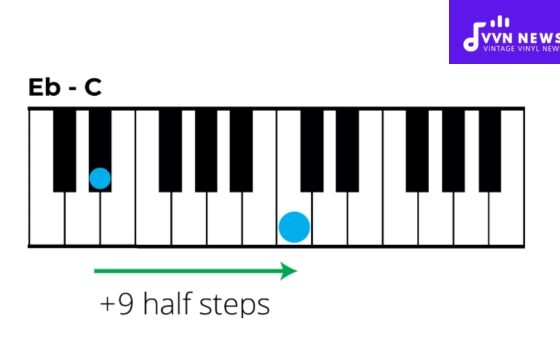In the world of music, the ability to transpose a song can open up a universe of opportunities. But if you are unfamiliar with the process, it may seem rather daunting at first.
So, how to transpose music? Whether you’re a budding musician hoping to adapt a melody for your instrument’s range or simply someone looking to experiment with familiar songs in new keys, this guide is tailor-made for you.
This – transposition isn’t merely about shifting notes up or down; it’s about maintaining the same harmonic relationships across different musical keys.
Since every piece of music cannot be played on every instrument in its original key, transposing ensures that whatever tunes strike your fancy can be adjusted for your particular voice or instrument.
What is Music Transposition and Why is it Important?
Music transposition refers to the process of changing the key or pitch of a musical piece while maintaining its structure and melody.
It involves shifting all the notes by a consistent interval, either up or down. Transposing music is essential for various reasons, making it an important skill for musicians to learn.
The Importance of Music Transposition
- Accommodating Different Instruments: Different musical instruments have varying ranges and capabilities. Transposing music allows musicians to adapt a piece to suit different instruments, ensuring that all parts can be played comfortably.
- Adapting to Vocal Ranges: Singers often have unique vocal ranges, and transposing music enables them to perform songs in keys that are better suited to their voices. This allows singers to showcase their strengths and abilities with greater ease.
- Creating Desired Sound: Transposing music can also be used as a creative tool. By changing the key of a song, musicians can alter its mood or atmosphere according to their artistic vision. It allows for experimentation and personalization in performance.
- Enabling Collaboration: When musicians from different backgrounds come together to play together or perform in an ensemble, there may be a need for transposition. By being able to transpose music, performers can overcome the challenge of incompatible keys and work together seamlessly.
- Expanding Musical Knowledge: Learning how to transpose broadens your music theory and increases your overall skill set as a musician. It opens up opportunities for learning new compositions, analyzing different musical structures, and gaining proficiency in playing multiple instruments.
Music transposition plays a crucial role in adapting music to individual needs and preferences while maintaining its essence and integrity.
How Does Music Transposition Work?
Transposing music involves moving every note in a piece uniformly by a certain interval (e.g., whole step or half step) up or down.
Here’s a basic step-by-step guide to help you transpose a piece of music:
- Identify the Key: Determine the key of the original piece. This is usually indicated at the beginning of the sheet music or in chord symbols.
- Determine the Desired Key: Decide on the key to which you want to transpose the piece. Consider factors such as vocal range, instrument capabilities, or desired sound.
- Interval Relationships: Familiarize yourself with how different intervals relate to each other in terms of half steps or semitones. This will help you know how many steps to transpose each note.
- Determine the Interval: Calculate the interval between the original key and the desired key. For example, if you are transposing from C major to D major, this is a whole tone or a whole step higher.
- Apply Transposition: Shift every note in the original piece by the determined interval while maintaining their relationships and positions within chords and melodies.
- Adjust Chords (if applicable): If you are transposing chords, ensure that they adhere to proper harmonic relationships between the melody and other parts of the music.
Transposing music may take some time and effort initially, but with practice and experience, it will become easier and more intuitive.
Also Read: B Flat Minor Pentatonic Scale [Create Emotive Music In Minutes]
How Do Different Instruments Affect Transposition Needs?

When it comes to transposing music, how different instruments are tuned and their ranges are crucial.
Each instrument has its unique sound and specific pitch range, which can greatly impact the transposition process.
Let’s take a closer look at how different instruments affect the need for transposition.
Transposing Instruments
Certain instruments, known as transposing instruments, are designed to play in a different key than the written note.
This means that when you read a C on sheet music, it may sound like a different note when played on these instruments.
Examples of transposing instruments include the clarinet, saxophone, trumpet, and French horn.
Transposition is necessary for these instruments because it ensures that they can play alongside non-transposing instruments while maintaining proper harmony.
For instance, if a B-flat clarinet plays a written C on sheet music, it will produce a B-flat note.
Non-Transposing Instruments
On the other hand, non-transposing instruments produce the same pitch as written on sheet music.
This includes instruments like the piano, guitar, violin, and flute. When playing these instruments, there is no need for transposition unless desired for creative purposes or to accommodate other musicians.
Vocal Range
For singers or vocalists, your vocal range is vital when considering transposition needs.
The vocal range refers to the span between the highest and lowest notes you can comfortably sing without straining your voice.
If a song’s original key does not suit your vocal range or feels challenging to sing, you may need to transpose it to a higher or lower key that better aligns with your capabilities.
Accompanying Instruments
When performing as part of an ensemble or band, it’s essential to consider how different instrument ranges interact with each other. Some instruments naturally have higher pitches (e.g., piccolo), while others have lower pitches (e.g., tuba).
Transposition can be used to ensure that all instruments play coherently and harmoniously.
By adjusting the written notes, you can maintain the desired musical texture and balance within the ensemble.
Also Read: B Minor Pentatonic Scale [Inject Your Music With Dramatic Flair]
Adapting to Different Genres
Transposition can also be used to adapt music to different genres or musical styles. For example, if you want to perform a classical piece on a jazz saxophone, you may need to transpose the music to fit the transposing nature of the instrument and match the style of jazz.
Determining the impact of different instruments affect transposition needs allows musicians and vocalists to collaborate effectively and create compelling performances.
How To Transpose Music?

Transposing music may seem daunting at first, but with a step-by-step approach, it can become a straightforward process. Here’s a guide to help you transpose music accurately:
Determine the Key of the Original Piece
Before you begin transposing, identify the key of the original piece. This key will serve as your starting point.
- Identify the Key You Want to Transpose: Decide on the desired key for your transposition. This could be based on your vocal range or the range of an instrument you want to play.
- Determine the Interval Between Keys: The difference between the original key and the desired key will dictate how much you need to transpose. For example, if you want to transpose from C major to G major, there is a perfect fifth interval between them.
- Key Signature: Familiarize yourself with key signatures and their relationship with each other. This will help you identify which notes need alteration due to key changes.
- Identify Accidentals: Look for any accidentals (sharps or flats) that appear in the sheet music. These accidentals will need to be adjusted accordingly during transposition.
- Use a Transposition Chart or Formula: A transposition chart or formula can simplify the process for beginners. This tool provides guidance on which note needs to be played instead of another during transposition.
- Shift Every Note by the Interval: Take each note in the original piece and shift it up or down by the interval determined earlier. Be sure to maintain consistent intervals throughout the song.
- Adjust Chords and Harmonies: Make adjustments to chords and harmonies based on note shifts to maintain proper tonality and sound quality.
- Practice and Familiarize Yourself with Patterns: As you gain more experience transposing music, you’ll begin to recognize common patterns and intervals. This will help speed up the process and enable you to transpose on the spot.
Transposing music requires practice and patience. Don’t be discouraged if it takes time to get comfortable with the process.
With dedication and persistence, you’ll soon become proficient in transposing music.
Also Read: C Sharp Major Pentatonic Scale [Crisp & Clear Tones For Your Music]
Tools or Software to Help with Transposition

Transposing music manually can be a complex and time-consuming process, but fear not! There are several tools and software available that can make transposing music a breeze.
Music Notation Software
One of the most popular options for transposition is music notation software. Programs such as Finale and Sibelius offer robust capabilities for transposing music.
With these tools, you can easily input your musical score and then simply select the desired key to transpose into. The software will automatically update all the notes accordingly, saving you tons of time and effort.
Transposition Apps
For musicians on the go, transposition apps can be incredibly handy. Apps like forScore or Anytune allow you to import sheet music or audio files and transpose them instantly.
You can also adjust the tempo and playback speed to suit your preference.
Online Transposition Tools
Several websites offer online transposition tools that are both user-friendly and accessible from any device with an internet connection.
Websites like Transposr, Chordie, or even a simple Google search for “music key transposer” will provide you with a range of options to choose from.
Most of these tools will allow you to input the original key and desired key, after which they will generate the transposed version for you.
Some even provide additional features like chord charts, audio playback, and instrument-specific transpositions.
It’s important to note that while these tools make transposing music easier, having a solid understanding of music theory is still helpful in ensuring accuracy.
FAQ About transposing music
Can I transpose music for any instrument?
Yes, music can be transposed for any instrument. The process may vary depending on the instrument, but the concept of shifting the pitch remains the same.
What is the most common reason for transposing music?
The most common reason for transposing music is to accommodate different vocal ranges. By changing the key, singers can perform songs comfortably within their own vocal range.
How do different instruments affect transposition needs?
Different instruments have varying pitch ranges and key limitations. For example, a trumpet player may need to transpose if a piece is written in a key that doesn’t suit their instrument’s natural range.
Are there specific rules or guidelines for transposing music?
Transposition follows musical theory principles, such as maintaining the relationship between notes and scales in the original piece. It’s important to know key signatures and intervals when transposing.
Are there tools or software to help with transposition?
Yes, there are various tools and software available that can assist with transposition. These include mobile apps, online resources, and notation software that allow you to easily change keys and transpose music accurately.
Conclusion
Transposing music is a valuable skill that can enhance your musical abilities and flexibility.
With the concept of transposition and following the step-by-step process outlined in this article, you can confidently transpose music to accommodate different instruments or adapt to vocal ranges.
Remember to practice regularly and be patient with yourself as you develop this skill.
So go ahead and explore the world of transposition, unlock new musical possibilities, and take your playing to new heights!








